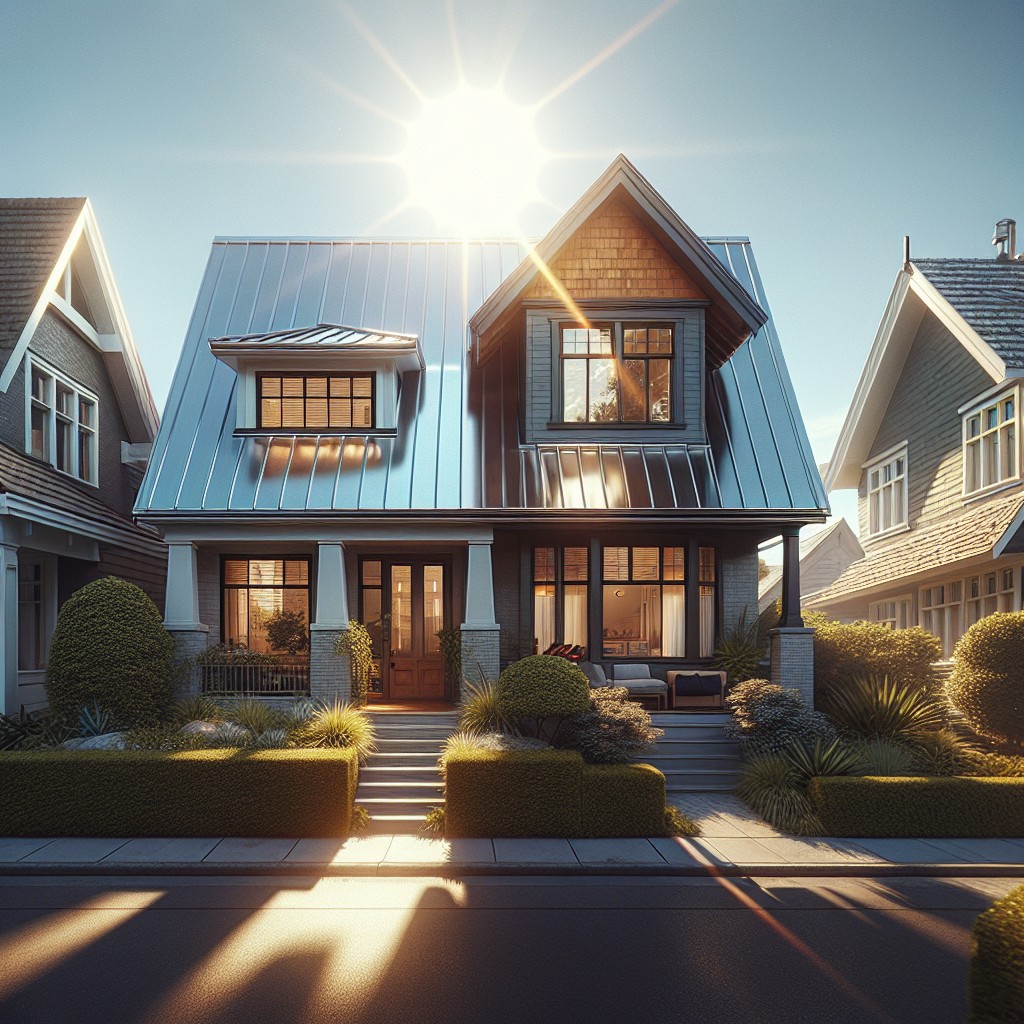Last updated on
Discover the cost comparison between metal roofing and shingles to make an informed decision for your home.
Key takeaways:
- Metal roofs are made from steel, aluminum, or copper, while shingles are made of asphalt.
- Metal roofs last up to 50 years or more, while shingles last 15 to 30 years.
- Installing metal roofing is more complex than installing asphalt shingles.
- Metal roofs are lighter and can reduce strain on the structure.
- Metal roofs offer a modern appearance, while shingles have more design options.
Metal Roof Vs. Shingles Key Differences

Understanding the fundamental distinctions between metal and shingle roofing systems is instrumental in making an informed decision.
Material: Metal roofs are typically constructed from steel, aluminum, or copper, while shingles are most commonly made of asphalt.
Durability: Metal roofing is known for its resilience, often withstanding extreme weather conditions and lasting up to 50 years or more. Asphalt shingles have a shorter lifespan, averaging 15 to 30 years.
Installation: Metal roofing requires specialized skills and tools for installation, which can be more complex compared to the simpler process of installing asphalt shingles.
Weight: Metal roofs are significantly lighter than their asphalt shingle counterparts, which can reduce strain on the structure of a building.
Aesthetics: While metal roofs offer a sleek, modern appearance and can be manufactured to resemble other materials, shingles provide a traditional look with a wider variety of color and design options.
Maintenance: Both require maintenance, but metal roofing generally demands less frequent attention, being more resistant to mold, mildew, and other common roofing issues.
Costs
When evaluating the initial outlay, shingles generally offer a more budget-friendly option compared to metal roofing. Asphalt shingles, the most common type, are widely available and lower in cost, reflecting in the price of installation. Metal roofs, conversely, command a higher price due to material and specialized labor costs.
It is critical, however, to consider not just upfront expense but also long-term investment value. The durability and longevity of metal can lead to decreased maintenance and replacement costs over time, potentially offsetting the initial premium. Moreover, metal roofs can contribute to energy savings by reflecting solar heat, which may reduce cooling costs in warmer climates.
It’s therefore essential to evaluate cost in the context of the roof’s expected lifespan and potential energy efficiencies.
Longevity
Metal roofs typically offer a lifespan of 40 to 70 years depending on the material. They are less susceptible to decay, mold, and pest damage. The durability largely results from the inherent strength of metal and its resistance to extreme weather conditions such as heavy snow, hail, and fire.
In contrast, asphalt shingles, which are the most common type for shingled roofs, usually last between 15 to 30 years. Their life expectancy can be influenced by factors such as climate, roof design, and maintenance diligence. Shingles are prone to algae and moss growth, can be damaged by high winds, and may deteriorate more quickly under direct UV exposure.
The superior longevity of metal roofing may lead to a lower frequency of replacement, which is an important factor to consider when comparing lifetime costs and the value provided over the lifespan of the roof.
Efficiency
Metal roofs often boast superior energy efficiency compared to asphalt shingles due to their reflective properties. They reflect the sun’s rays, which can help keep homes cooler during sunny periods, potentially reducing cooling costs. Additionally, some metal roofing is treated with special pigments that enhance energy efficiency.
On the other hand, asphalt shingles absorb more heat, which can lead to warmer attic spaces and higher air conditioning expenses. However, modern shingles may have energy-efficient options, like cool-roof technology, which uses granules that reflect solar energy.
Both materials offer insulation benefits, but overall, metal roofing typically leads to greater efficiency gains over the lifespan of the roof. It’s important to note that proper installation and adequate attic insulation are critical factors that will influence the overall efficiency of any roofing system.
Pros and Cons of Metal Roofs Vs. Shingled Roofs
Metal roofs offer impressive durability, often lasting 40-70 years, compared to the average 15-30-year lifespan of asphalt shingles. They can withstand high winds, are fire-resistant, and reflect solar radiant heat, which may reduce cooling costs. However, metal roofing is typically more expensive upfront and may be prone to denting from hail.
In contrast, shingle roofs are less expensive to install and are favored for their traditional aesthetic. They are easier to repair and a good choice for homeowners looking for a cost-effective solution. On the downside, they are more susceptible to weather-induced wear and can contribute to higher attic temperatures, potentially increasing air conditioning needs.
Related
- How Much Does it Cost to Put a Metal Roof on a 2,000 Sq Ft House: Pricing Factors Explained
- Metal Roof vs Shingles: Comparing Costs, Durability and Aesthetic Appeal
- Metal Roof Cost: Understanding Pricing and Value Factors
- Benefits of Metal Roofing: A Detailed Comparative Analysis
- How Much Does a Metal Roof Cost: Factors & Price Range Estimates
